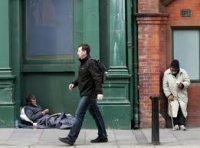
The Minister for Employment Affairs and Social Protection Regina Doherty T.D., has welcomed the continuing downward trend in national poverty rates, as shown in data published by the Central Statistics Office in the Survey on Income and Living Conditions 2016 today.
The Minister said a very positive finding is the fall in basic deprivation to 21% in 2016. This was a continuation of the yearly decline in deprivation rates which started after 2013, when deprivation peaked at over 30%.
The consistent poverty rate (a combined measure of low relative income and basic deprivation) was 8.3% in 2016 – this represents a further small decline on the 8.7% rate in 2015, and the peak rate of 9.1% in 2013.
The Minister noted that median disposable income increased by 3.0% to €20,597 per person in 2016 (with the increase in real terms being slightly higher at 3.1%. The rise in incomes was due to both increased employment and higher earnings for those at work. Unemployment fell from a peak of 15.4% in 2012 to 8.4% in 2016. [It has since fallen to 6.1% as of November 2017.]
Minister Doherty said: “I am pleased to see the continued social dividends from the recovery reflected in these latest poverty figures. It is encouraging to see that improvements in living conditions and in incomes were sustained into 2016 – even though, at the time these data were collected, social welfare payments remained frozen at the reduced levels introduced in 2009. With wide-ranging increases in payments rates in the 2017 and 2018 Budgets, and the further improvement in the economy and in employment in 2017, I am confident that these trends have continued. The Government focus on increased spending on social supports in recent Budgets will clearly make a difference in the lives of those who are vulnerable within our society”
The Minister noted that the social welfare system (excluding pensions) continued to perform strongly in 2016, reducing the at-risk-of-poverty rate from 33.6% before social transfers to 16.5% after social transfers. This equates to a poverty reduction effect of 51%; ensuring Ireland remains one of the best performing EU countries in reducing poverty through social transfers.
Social transfers also played an important role in reducing income inequalities in Ireland (as measured by the Gini coefficient) from 53.7 to 30.6 in 2016; an income inequality reduction effect of 43%.
Recent budgets have been forward looking, allocating limited resources in a prudent way, to make sure that everyone benefits from the recovery. For instance, Budgets 2017 and 2018 increased the weekly rates of payment for working-age schemes and raised the income disregard for one-parent family payment and jobseeker’s transition payment recipients. A new €500 annual Cost of Education Allowance was introduced for Back to Education Allowance participants with children from September. This will help parents, including lone parents, to return to education. The focus of these budgets has also been on the provision of services rather than simply on income supports e.g. the new Single Affordable Childcare Scheme.
The Minister concluded: “In 2018, my focus as Minister for Employment Affairs and Social Protection will be on supporting people and families as they make the transition from welfare to work and strengthening welfare supports for those who may need them.”
ABC Comment: The Survey on Income and Living Conditions (SILC) is an annual survey carried out by the Central Statistics Office (CSO) of a representative sample of about 5,000 households or about 13,200 individuals in Ireland. The survey collects information on the income and living conditions of different households in Ireland, in order to derive indicators on poverty, deprivation and social exclusion. It is carried out in every EU country under EU legislation and commenced in Ireland in June 2003. The findings for 2016 can be found at: www.cso.ie/en/statistics/socialconditions/. This release presents results based on data collected in the period January 2015 to December 2016.
Basic deprivation: People are regarded as experiencing basic deprivation if they live in a household deprived of 2 or more of the 11 basic deprivation items because they could not afford them (i.e. not by choice). The figure in 2015 was 25.5%.
At-risk-of-poverty: People are regarded as being at-risk-of-poverty if their equivalised income is below 60% of the median income. In 2015, the at-risk-of poverty threshold was €12,000 per annum or €230 per week for a single person. The at-risk-of-poverty figure in 2015 was 16.9%.
Consistent poverty is the measure used to set the national social target for poverty reduction. It is the overlap of at-risk-of poverty and basic deprivation. The consistent poverty rate was 8.7% in 2015.
Gini coefficient is the relationship between cumulative shares of the population arranged according to the level of income and the cumulative share of total income received by them. If there was perfect equality (i.e. each person receives the same income) the Gini coefficient would be 0. A Gini coefficient of 100 would indicate there was total inequality and the entire national income was in the hands of one person.
Poverty reduction effect of social transfers: The impact of social transfers is measured by the percentage reduction, in absolute and relative terms, in the at-risk-of-poverty rate as a result of social transfers (excluding pensions). In 2015, social transfers (excluding pensions) reduced the at-risk-of poverty rate from 34.9% to 16.9%, or 18 percentage points in absolute terms. This represents a poverty reduction effect of 52.9%
Leave a comment
Make sure you enter all the required information, indicated by an asterisk (*). HTML code is not allowed.
Join
FREE
Here










